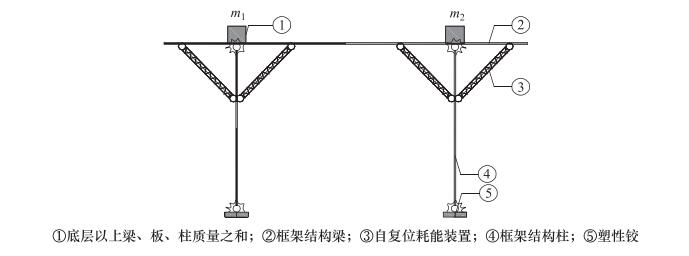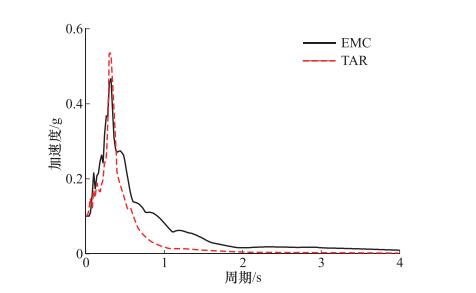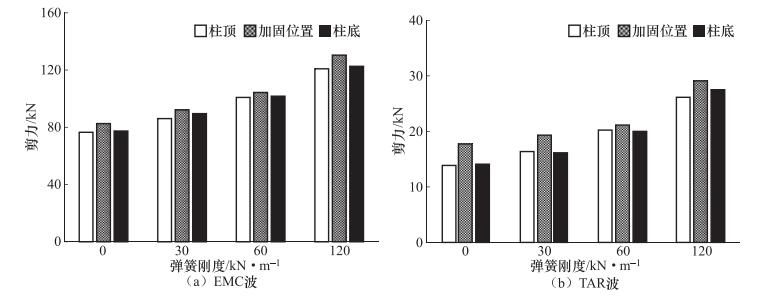The Research on Self-centering Reinforcement Method for Reinforced Concrete Frame Structure
-
摘要: 为减小结构震后残余位移,提高框架结构的震后可修复性,本文提出1种自复位耗能加固方法。以一典型框架结构为例,对比传统框架结构和采用自复位耗能装置加固框架结构的地震响应,并研究自复位耗能装置各参数对加固后结构抗震性能的影响。结果表明:采用自复位耗能装置加固框架结构可有效减小残余位移,但有可能增大结构内力响应;结构的残余位移随着弹簧刚度的增大而减小,结构的内力响应也随之增大;预拉力越大,结构内力响应增加越小,在实际工程中应对自复位加固装置的弹簧刚度和预拉力进行优化以获得最优的自复位加固效果。Abstract: In order to reduce the residual deformation of the structure after earthquake and improve the reparability of the frame structure after earthquake, a self-centering energy dissipation technique is proposed in this paper. Taking a typical frame structure as an example, the seismic response of the traditional frame structure and the frame structure with additional self-centering energy dissipation device is analyzed, and the influence of the parameters of self-centering energy dissipation device on the seismic response of the frame structure is studied. The results show that the reinforcement of frame structures with self-centering energy dissipation technique can effectively reduce the residual deformation, but it may increase the internal force response of the structure. The residual displacement of the structure decreases with the increase of spring stiffness, and the internal force response of the structure increases. The bigger the pre-tension force is, the smaller the internal force response of the structure increases. In practical engineering, the spring stiffness and pre-tension of the self-centering reinforcement device should be optimized to obtain the optimal self-centering reinforcement effect.
-
表 1 自振频率对比(单位:rad/s)
Table 1. Comparison of natural frequency (unit: rad/s)
阶数 原结构 加固结构 1 2.98 3.24 2 17.36 19.67 3 19.64 27.38 表 2 残余位移值对比
Table 2. Comparison of residual displacements
地震波 原结构/mm 加固结构/mm 减震率/% EMC 26.29 9.39 64.28 TAR 4.56 1.56 65.79 表 3 框架柱弯矩峰值对比
Table 3. Comparison of maximum bending moments of frame columns
地震波 位置 原结构/kN·m 加固结构/kN·m 放大率/% EMC 柱顶 612 645 5.39 加固处 602 676 12.29 柱底 620 652 5.16 TAR 柱顶 485 525 8.25 加固处 472 562 19.07 柱顶 492 542 10.16 表 4 框架柱剪力峰值对比
Table 4. Comparison of maximum shear force of frame columns
地震波 位置 原结构/kN 加固结构/kN 放大率/% EMC 柱顶 94.42 100.64 7.45 加固处 91.85 104.16 13.04 柱底 95.17 101.35 6.32 TAR 柱顶 18.67 20.42 9.37 加固处 17.85 21.12 18.32 柱顶 18.54 20.10 8.41 -
吕西林, 陈云, 毛苑君, 2011.结构抗震设计的新概念——可恢复功能结构.同济大学学报(自然科学版), 39(7):941-948. doi: 10.3969/j.issn.0253-374x.2011.07.001 吕西林, 崔晔, 刘兢兢, 2014a.自复位钢筋混凝土框架结构振动台试验研究.建筑结构学报, 35(1):19-26. http://d.old.wanfangdata.com.cn/Periodical/jzjgxb201401003 吕西林, 周颖, 陈聪, 2014b.可恢复功能抗震结构新体系研究进展.地震工程与工程振动, 34(4):130-139. http://d.old.wanfangdata.com.cn/Conference/8421961 谢文, 孙利民, 魏俊, 2014.附有结构"保险丝"构件的桥墩抗震性能试验研究及其应用.中国公路学报, 27(3):59-70. http://www.wanfangdata.com.cn/details/detail.do?_type=perio&id=zgglxb201403009 中华人民共和国住房和城乡建设部, 2016.GB 50011-2010建筑抗震设计规范(附条文说明)(2016年版).北京: 中国建筑工业出版社. 祝英杰, 2014.结构抗震设计.2版.北京: 北京大学出版社. Applied Technology Council (ATC), 2012. Seismic Performance Assessment of Buildings: Volume 1-Methodology, FEMA P-58, Redwood City, CA. Luco N., Bazzurro P., Cornell C. A., 2004. Dynamic versus static computation of the residual capacity of a mainshock-damaged building to withstand an aftershock. In: Proceedings of the 13th World Conference on Earthquake Engineering. Vancouver, Canada: WCEE. NEES/E-Defense, 2010. Report of the seventh joint planning meeting of NEES/E-defense collaborative research on earthquake engineering. Berkeley: University of California. Paulay T., Priestley M. J. N., 1999.钢筋混凝土和砌体结构的抗震设计.戴瑞同, 译.北京: 中国建筑工业出版社. Vargas R., Bruneau M., 2006. Investigation of the structural fuse concept. New York: State University of New York. -




 下载:
下载:












